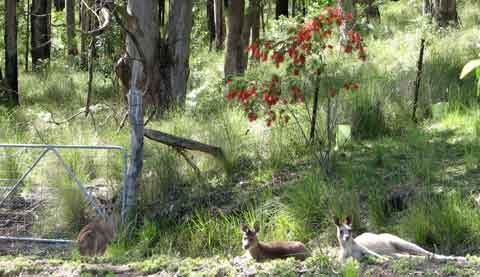
Early morning, sunshine after days of rain, the grass still soggy. The kangaroo family has decided that just inside the forever-open gate, on the hard-packed clay track, is the driest place to rest.
They know my car only moves out of the shed every few weeks — the track’s more for them than for me.
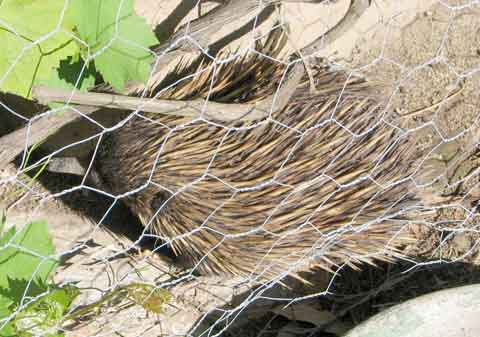
Midday, and one of the echidnas has been poking about on the same track, then working its way down some steps cut into the bank. It had reached the flat area near the cabin and was moseying along the wall towards my steps.
I’d had to net the ornamental grape there, so its shoots had a chance to grow to be my summer shade. Having already seen a joey go under it and panic somewhat, suddenly I saw a potential problem in the combination of spikes and netting, should the echidna go in under the wire.
As it did, but kept going, under the verandah and out. Untangling an echidna might not have been easy.
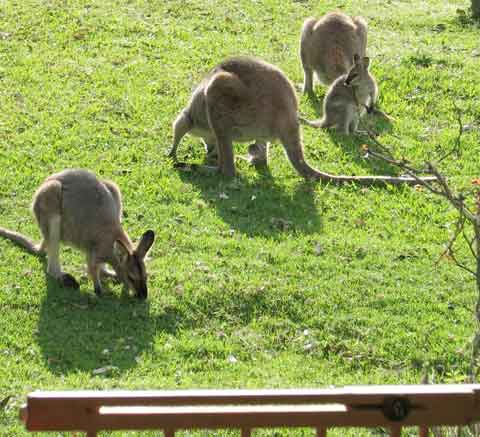
Late afternoon, and over the top of the netted toddler barrier, a wallaby family was mowing the grass near the steps. I’m no longer sure if I’m netted in, or they out. Lucky I have long legs for a shortie and can step over this barrier.
I had to add the netting because one day I surprised a joey munching on the plants on the verandah, having got through the wooden bars.
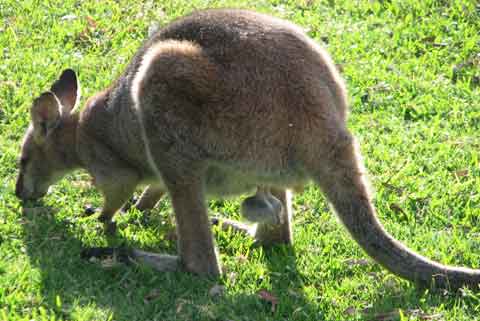
I don’t mean to be voyeuristic but sometimes the colloquial greeting, ‘How’re they hanging?’ takes on new meaning. And to think they leap through the tall tussocks without getting caught up or damaged…
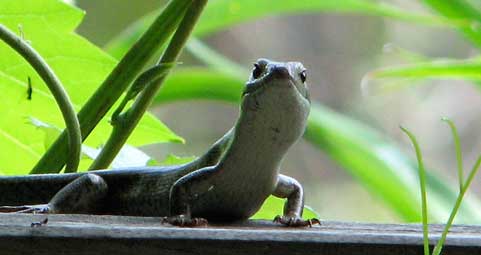
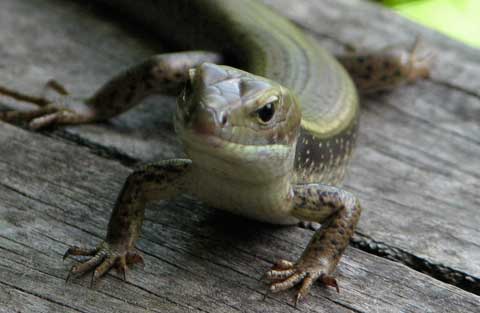

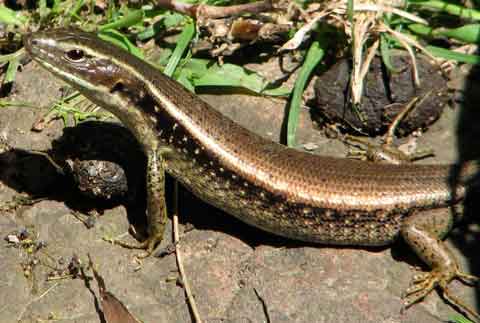
 Recently I met Laura, a delightful young Spanish biologist with a passion for primates, while she was WWOOFing at
Recently I met Laura, a delightful young Spanish biologist with a passion for primates, while she was WWOOFing at 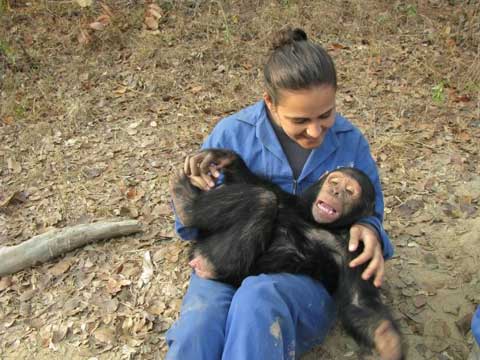
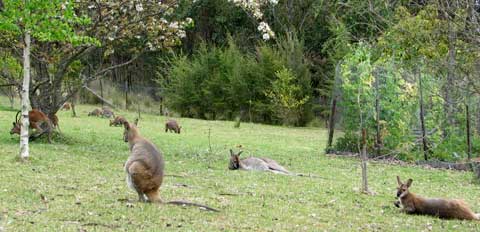
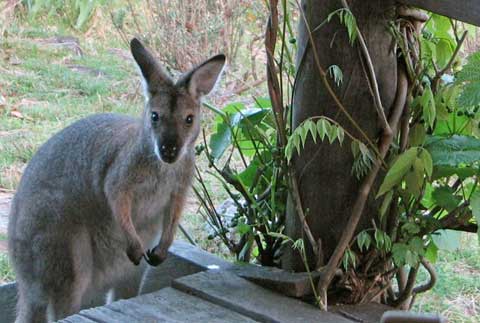
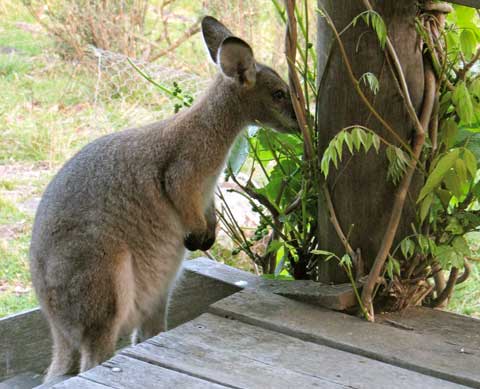
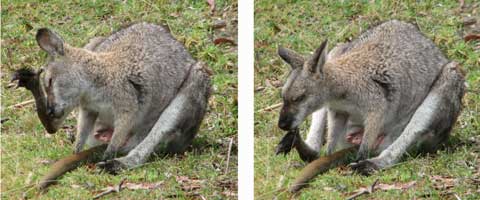
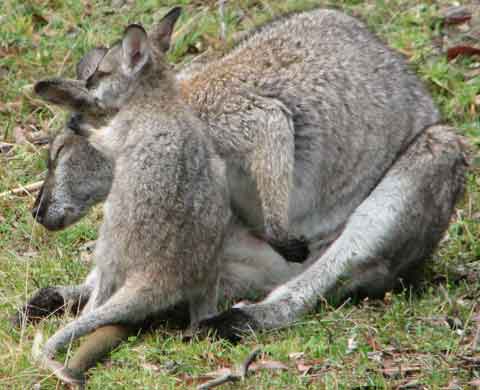
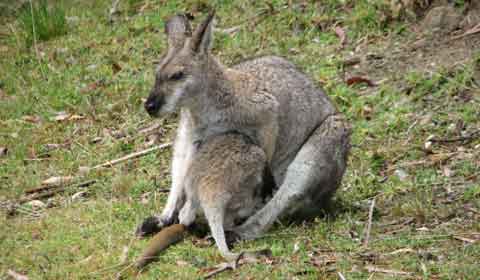
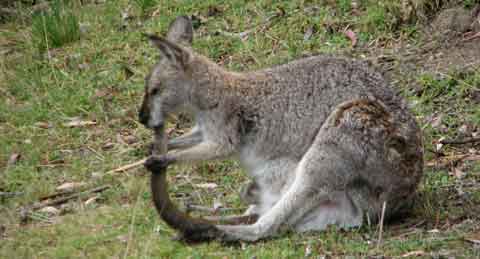
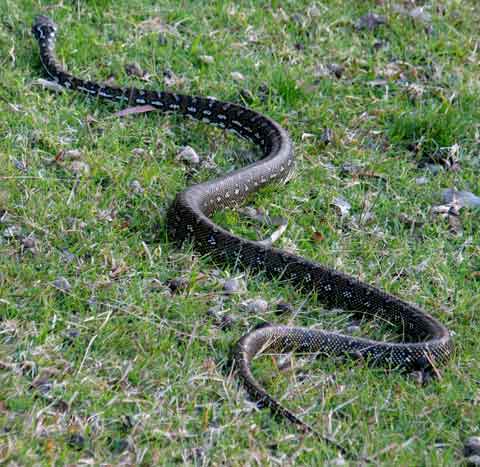
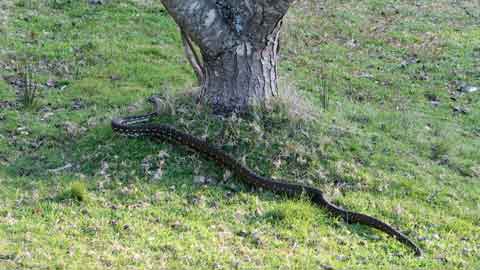

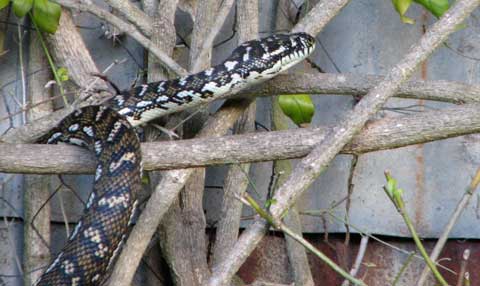
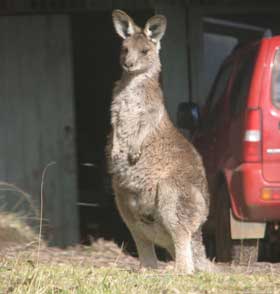 While the wallabies have more than made themselves at home here in my yard-that-was-once-a-garden, the kangaroos have been wary, staying over in the far orchard end and taking off if they saw me. But I recently spotted this young one through my window; being up near the shed, it was unusually close to my cabin, but didn’t notice me snapping its picture though the window. Then I looked along the track from the shed, even closer to me, and there they were, a little family of kangaroos sprawled about on track and bank, lazy and unperturbed.
While the wallabies have more than made themselves at home here in my yard-that-was-once-a-garden, the kangaroos have been wary, staying over in the far orchard end and taking off if they saw me. But I recently spotted this young one through my window; being up near the shed, it was unusually close to my cabin, but didn’t notice me snapping its picture though the window. Then I looked along the track from the shed, even closer to me, and there they were, a little family of kangaroos sprawled about on track and bank, lazy and unperturbed.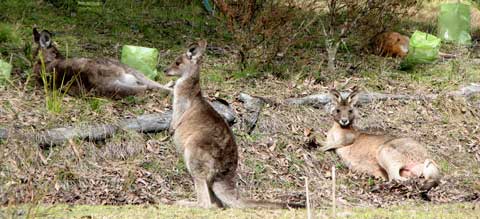
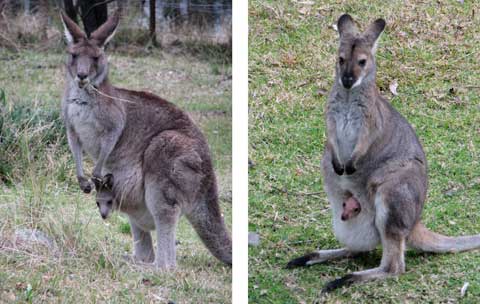
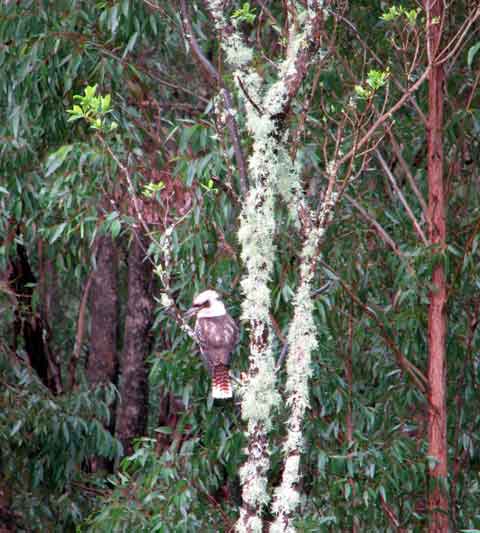
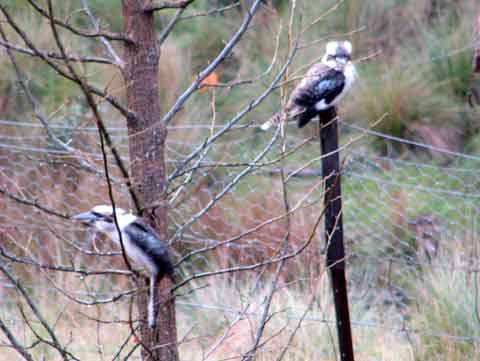
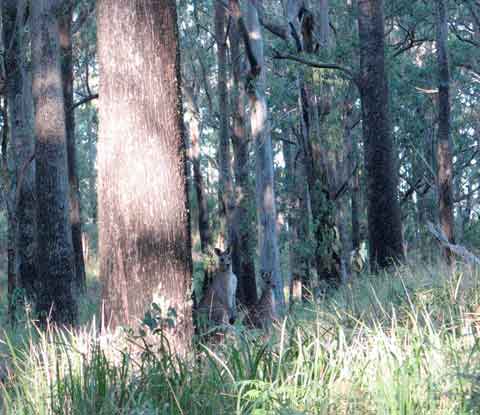 Out in the real forest it is always a matter of double-take with our cleverly camouflaged creatures; I think I see a dark shadow sway, a tree trunk bend. Kangaroo? Wallaroo? One blink and they might be gone.
Out in the real forest it is always a matter of double-take with our cleverly camouflaged creatures; I think I see a dark shadow sway, a tree trunk bend. Kangaroo? Wallaroo? One blink and they might be gone.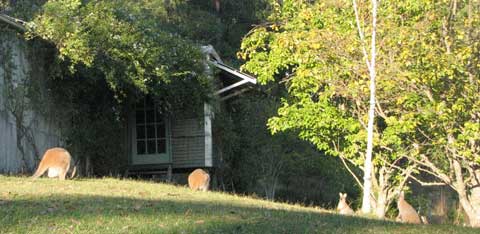 But now that my house yard is their territory too, I get different, more domestic views of my macropod neighbours. In the early mornings, as the sun begins to soak up the dew and highlight the trees, it now also picks out fluffy ears, closed sundrowsing eyes, busily feeding backs, and the many babies, cosily enpouched or skittishly out-pouched.
But now that my house yard is their territory too, I get different, more domestic views of my macropod neighbours. In the early mornings, as the sun begins to soak up the dew and highlight the trees, it now also picks out fluffy ears, closed sundrowsing eyes, busily feeding backs, and the many babies, cosily enpouched or skittishly out-pouched.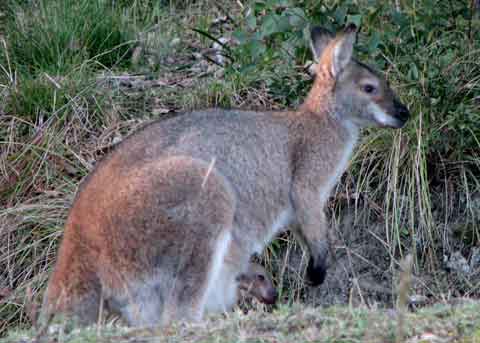
 Now that all the Refuge animals have free run of my house yard, it’s been interesting to see the sharing arrangements develop, both with me as the sole human, and with the other, better adapted, species.
Now that all the Refuge animals have free run of my house yard, it’s been interesting to see the sharing arrangements develop, both with me as the sole human, and with the other, better adapted, species.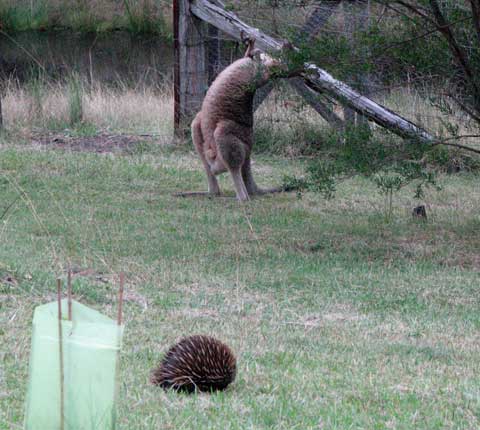 But they are an amiable breed, and co-exist happily with anyone else, even me. This wallaby with the itchy tummy is almost overbalancing as he scratches, with no thought of the echidna that trundles past, intent on its own business.
But they are an amiable breed, and co-exist happily with anyone else, even me. This wallaby with the itchy tummy is almost overbalancing as he scratches, with no thought of the echidna that trundles past, intent on its own business.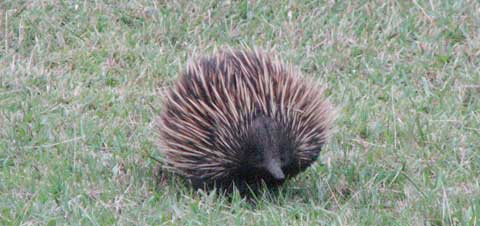 I have learnt that minding one’s own business is the key for my survival here too — not that interfering with an echidna would be on my mind!
I have learnt that minding one’s own business is the key for my survival here too — not that interfering with an echidna would be on my mind! My house wallaby’s joey is venturing more than its head out now. From the low-slung safety and warmth of the pouch, it projects its front legs and paws, touching the grass.
My house wallaby’s joey is venturing more than its head out now. From the low-slung safety and warmth of the pouch, it projects its front legs and paws, touching the grass.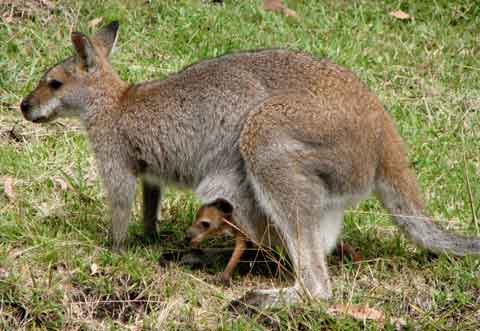 Big soft ears turning, nose sniffing, eyes alert, our joey is growing up fast. Its fur is still fine, not enough to keep it warm in these 10-14 degree autumn days. On the cusp of babyhood, it has the best of both inside and outside worlds, able to try touch and taste, but retreat to snooze, suckle and be safe.
Big soft ears turning, nose sniffing, eyes alert, our joey is growing up fast. Its fur is still fine, not enough to keep it warm in these 10-14 degree autumn days. On the cusp of babyhood, it has the best of both inside and outside worlds, able to try touch and taste, but retreat to snooze, suckle and be safe.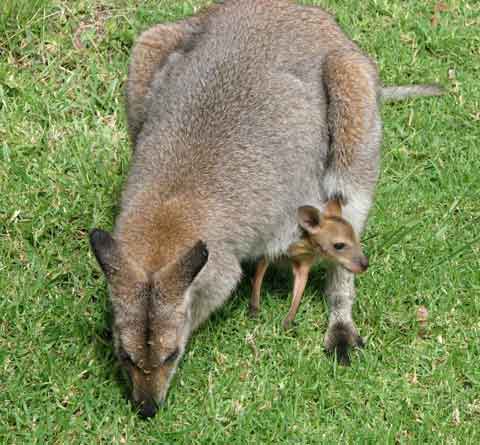 I am always astonished at how big the joeys are when their mothers continue to allow them to ride in the pouch. This one has a way to grow yet the pouch is barely clearing the ground now. Tussock country can’t be easy with a gangly joey swinging below.
I am always astonished at how big the joeys are when their mothers continue to allow them to ride in the pouch. This one has a way to grow yet the pouch is barely clearing the ground now. Tussock country can’t be easy with a gangly joey swinging below. The wallaby Mum I mentioned is still coming in and resting by the house wall.
The wallaby Mum I mentioned is still coming in and resting by the house wall. 